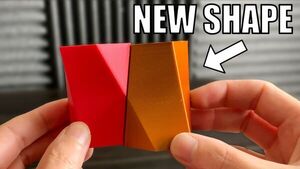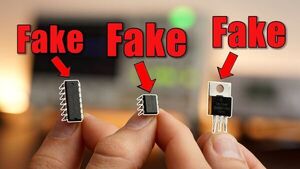2022-06-09 - Nº 371
Editorial
Esta é a Newsletter Nº 371 que se apresenta com o mesmo formato que as anteriores. Se gostar da Newsletter partilhe-a!
Todas as Newsletters encontram-se indexadas no link.
Esta Newsletter tem os seguintes tópicos:
Faz hoje anos que nascia, em 1768, o engenheiro mecânico anglo-americano Samuel Slater. Ele fundou a indústria americana do algodão-têxtil. Antes de deixar Nottingham e imigrar para os EUA em 1789, Slater aprendeu com Jedediah Strutt (sócio de Richard Arkwright) em Inglaterra. Uma vez nos EUA, encontrou apoio para construir a máquina de fiar e cardar Arkwright, com a qual estabeleceu a primeira fábrica de algodão de sucesso nos EUA em Pawtucket, Rhode Island, bem como muitas outras na região da Nova Inglaterra.
Faz também hoje anos que nascia, em 1781, o engenheiro e inventor inglês George Stephenson. Ele foi um dos principais pioneiros da locomotiva de caminho-de-ferro. A primeira linha férrea que construiu correu de Darlington a Stockton, que abriu a 27 de Setembro de 1825 quando grandes multidões o viram aos comandos da Locomotion ao puxar 36 vagões cheios de sacos de carvão e farinha. A viagem inicial de pouco menos de 9 milhas demorou duas horas. Os ensaios Rainhill de 1829, foi uma competição para a construção da locomotiva mais rápida. Ganhou com a sua famosa locomotiva, a Rocket, que viajou a uma velocidade nunca vista de 36 milhas por hora. Stephenson construiu então a linha Liverpool para Manchester, que abriu a 15 de Setembro de 1830. Ele é considerado como uma das pessoas mais influentes da Revolução Industrial na Europa.
Faz igualmente hoje anos que nascia, em 1861, o químico russo Gustav Heinrich Johann Apollon Tammann. Ele ajudou a fundar a ciência da metalurgia e foi pioneiro no estudo da estrutura interna e propriedades físicas dos metais e suas ligas. Além disso, os seus estudos sobre equilíbrios heterogéneos (ou seja, o comportamento da matéria em função da composição química, temperatura e pressão) desempenharam um papel importante na sistematização da química inorgânica e contribuíram significativamente para o desenvolvimento da química física como disciplina. Em 1903, Gustav Tammann estabeleceu o primeiro Instituto de Química Inorgânica na Alemanha, antes de mudar o seu interesse de investigação para a química física dos metais e ligas.
Faz também hoje anos que nascia, em 1921, o inventor americano Forrest M. Bird. Ele desenvolveu o primeiro respirador médico fiável, de baixo custo e produzido em massa, o Bird Universal Medical Respirator para cuidados cardiopulmonares agudos ou crónicos. Para continuar o seu desenvolvimento e comercialização, fundou a Bird Products Corporation (1954). Testou-o em doentes tão gravemente doentes que se esperava uma falha cardiopulmonar, mas muitos deles sobreviveram devido ao seu aparelho - que ficou conhecido como "o pássaro". Bird continuou a fazer melhorias. Foi amplamente adoptado por hospitais em todo o mundo. O respirador "Babybird", introduzido em 1970, reduziu grandemente as mortes de crianças devido a problemas respiratórios.
Por fim, faz hoje anos que nascia, em 1930, o balonista americano Ben Abruzzo. Ele, com três companheiros de tripulação, fez o primeiro voo de balão transpacífico que foi também o mais longo voo sem escalas, na Double Eagle V. Treze andares de altura, o Double Eagle V com hélio, pilotado por Ben Abruzzo, Larry Newman, Ron Clark e Rocky Aoki do Japão, lançado de Nagashimi, Japão, a 10 de Novembro de 1981. Quando aterrou 84 horas, 31 minutos mais tarde na Floresta Nacional de Mendocino, Cal., o novo recorde de distância foi estabelecido em 5.768 milhas. Acompanhou também Maxie Anderson e Larry Newman no primeiro voo de balão transatlântico no Double Eagle II (11-17 de Agosto de 1978).
Em 1905, Albert Einstein publicou a sua análise da teoria quântica de Max Planck e a sua aplicação à luz. O seu artigo apareceu em Annalen der Physik. Embora não estivesse envolvido qualquer trabalho experimental, foi por estas ideias que Einstein ganhou o seu Prémio Nobel.
E nesta semana que passou os estados membros da união europeia chegaram a um acordo acerca da proposta para um carregador comum no espaço da união europeia. No Outono de 2024, o USB Tipo C tornar-se-á a porta de carregamento comum para todos os telemóveis. O acordo provisório sobre a directiva alterada relativa ao equipamento de rádio, estabelece uma única solução de carregamento para certos dispositivos electrónicos. Esta lei faz parte de um esforço mais amplo da UE para tornar os produtos na UE mais sustentáveis, para reduzir os resíduos electrónicos, e para facilitar a vida dos consumidores.
De acordo com as novas regras, os consumidores deixarão de precisar de um dispositivo de carregamento e cabo diferente cada vez que comprarem um novo dispositivo, e poderão utilizar um único carregador para todos os seus dispositivos electrónicos portáteis de pequena e média dimensão. Telemóveis, tablets, leitores electrónicos, auriculares, câmaras digitais, auscultadores e auscultadores, consolas de videojogos portáteis e altifalantes portáteis que são recarregáveis através de um cabo com fios terão de ser equipados com uma porta USB tipo C, independentemente do seu fabricante. Os computadores portáteis também terão de ser adaptados aos requisitos até 40 meses após a entrada em vigor.
Na Newsletter desta semana apresentamos diversas noticias, artigos científicos, projetos de maker e alguns vídeos interessantes.
 João Alves ([email protected])
João Alves ([email protected])
O conteúdo da Newsletter encontra-se sob a licença  Creative Commons Attribution-NonCommercial-ShareAlike 4.0 International License.
Creative Commons Attribution-NonCommercial-ShareAlike 4.0 International License.
Novidades da Semana

Deal on common charger: reducing hassle for consumers and curbing e-waste
"By autumn 2024, USB Type-C will become the common charging port for all mobile phones, tablets and cameras in the EU, Parliament and Council negotiators agreed today. The provisional agreement on the amended Radio Equipment Directive, establishes a single charging solution for certain electronic devices. This law is a part of a broader EU effort to make products in the EU more sustainable, to reduce electronic waste, and make consumers’ lives easier. Under the new rules, consumers will no longer need a different charging device and cable every time they purchase a new device, and can use one single charger for all of their small and medium-sized portable electronic devices. Mobile phones, tablets, e-readers, earbuds, digital cameras, headphones and headsets, handheld videogame consoles and portable speakers that are rechargeable via a wired cable will have to be equipped with a USB Type-C port, regardless of their manufacturer. Laptops will also have to be adapted to the requirements by 40 months after the entry into force." [...]
Outras Notícias
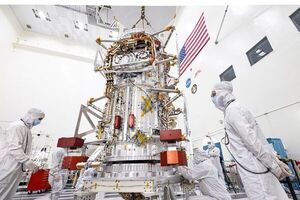
NASA’s Europa Clipper Mission Completes Main Body of the Spacecraft
"The agency’s mission to explore Jupiter’s icy moon takes a big step forward as engineers deliver a major component of the spacecraft. The main body of NASA’s Europa Clipper spacecraft has been delivered to the agency’s Jet Propulsion Laboratory in Southern California. Over the next two years there, engineers and technicians will finish assembling the craft by hand before testing it to make sure it can withstand the journey to Jupiter’s icy moon Europa. The spacecraft body is the mission’s workhorse. Standing 10 feet (3 meters) tall and 5 feet (1.5 meters) wide, it’s an aluminum cylinder integrated with electronics, radios, thermal loop tubing, cabling, and the propulsion system. With its solar arrays and other deployable equipment stowed for launch, Europa Clipper will be as large as an SUV; when extended, the solar arrays make the craft the size of a basketball court." [...]

Toshiba Adds Five New MOSFET Gate Driver ICs that Will Help Reduce Device Footprints
"Toshiba Electronic Devices & Storage Corporation ("Toshiba") has added five products to its lineup of MOSFET gate driver ICs in the TCK42xG Series for mobile devices such as wearables. The new products in the series are equipped with an overvoltage lockout function and control the gate voltage of an external MOSFET according to the input voltage. The new products are: “TCK420G” for 24V power lines; “TCK422G” and “TCK423G” for 12V power lines; “TCK424G” for 9V power lines; and “TCK425G” for 5V power lines. Along with the already launched “TCK421G” for 20V power lines, they are available now. With this addition, TCK42xG series now allow users to select a gate-source voltage from two types, 10V and 5.6V, offering coverage of more MOSFETs. In addition, the lineup of the different detection voltages for the input overvoltage lockout function allows the products to be used for power lines from 5V to 24V." [...]

Arm introduces new image signal processor to advance vision systems for IoT and embedded markets
"Image signal processors (ISPs) continue to be one of the most important information-generating devices, supporting a broad range of IoT vision system applications including commercial, industrial or home smart cameras, and drones. With increased demand for both more and higher quality image processing in future devices, Arm’s ISP technology roadmap is an area of continuing investment. Today, we are pleased to share the latest results of that work with the launch of the new Arm Mali-C55 ISP, the smallest and most configurable ISP from Arm to date, already proving popular with partners including our first public licensee, Renesas. The Mali-C55 delivers upgraded image quality features, works under a wide range of different lighting and weather conditions, and is designed to enable maximum performance and capability in area and power constrained applications, making it ideal for smart camera and edge AI vision use cases. This advanced technology will deliver improved capabilities in several markets – surveillance and security cameras will be able to detect more critical detail, such as recognizing the exact information on license plates traveling at up to 75mph; home cameras and security systems will capture higher resolution images both inside and out; and smart home hubs can efficiently include advanced features like secure visual unlock. For developers, we’re providing a complete software package for controlling the ISP, as well as a full set of tuning and calibration tools to help our partners to achieve the desired image quality for their application." [...]
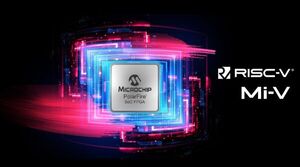
First RISC-V-Based System-on-Chip (SoC) FPGA Enters Mass Production
"Microchip’s Mi-V ecosystem has enabled customers to ramp products based on PolarFire® devices more quickly, from prototypes to production The first SoC Field Programmable Gate Array (FPGA) to support the royalty-free RISC-V open Instruction Set Architecture (ISA) has entered volume production, marking a major milestone in the evolution of embedded processors. As customers continue to adopt PolarFire® SoC FPGAs at a rapid pace, Microchip Technology Inc. (Nasdaq: MCHP) announces the production qualification for the MPFS250T and the previously announced MPFS025T. Microchip also announces that its Mi-V ecosystem continues to streamline RISC-V adoption while enabling a new class of smaller, more power-efficient and less-costly industrial, IoT and other edge-compute products. “We now have a large funnel of customers who have designed in the PolarFire SoC family with our suite of Mi-V tools and solutions,” said Shakeel Peera, vice president of marketing for Microchip’s FPGA business unit. “These customers have developed innovative products that bring best-in-class solutions to market with superior thermal and power efficiency, as well as unprecedented compute capability in small form factors. We are now writing a new chapter in the history of RISC-V with the availability of production-qualified SoC PolarFire devices.” PolarFire SoC FPGAs unlock new configurable processing opportunities with their hardened real-time, Linux®-capable RISC-V-based microprocessor subsystem on a fast FPGA fabric, backed by Microchip’s commitment to a product roadmap and long-term availability." [...]

STMicroelectronics and Sensory collaborate to enable mass-market adoption of embedded voice control through STM32Cube software ecosystem
"STM32 MCUs pair with Sensory’s VoiceHub technology to streamline development of voice-based user interfaces on wearables, IoT, and smart-home applications STMicroelectronics (NYSE: STM), a global semiconductor leader serving customers across the spectrum of electronics applications, and Sensory Inc., a leading provider of embedded speech recognition technology and an ST Authorized Partner, have announced a collaboration that will enable the STM32 microcontroller (MCU) user community to develop and prototype intuitive voice-based user interfaces for a wide range of smart embedded products. The joint efforts pair ST’s STM32 hardware and software with Sensory’s voice-control technologies, including the new VoiceHub online portal that supports seamless creation of embedded speech-recognition models using custom wake words, voice-control command sets, and large natural-language grammars in almost twenty languages and dialects. The solution is based on an STM32Cube software extension package and runs on a high-performance STM32H7 MCU, taking advantage of its architecture, internal Flash, SRAM, and high CPU speed. This combination plays a key role in increasing voice-control accuracy and minimizing command-recognition time. Hosting the voice application and speech models in the generous on-chip memory of the high-performance STM32 MCUs further boosts the system integration and ease of use, as well as lowers cost of ownership. “This collaboration sets to jump-start the development of embedded-voice user interfaces, adding friction-free command control and custom wake word to any device, from wearables to smart-home appliances,” said Ricardo De Sa Earp, Executive Vice President, General-Purpose Microcontroller Sub-Group Vice President, STMicroelectronics." [...]
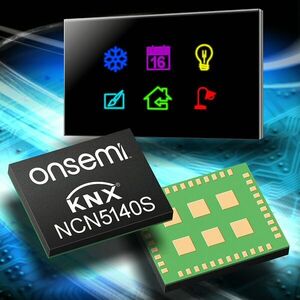
onsemi Accelerates Building Automation with Industry First Solutions for KNX and Power over Ethernet (PoE)
"Supporting major building automation protocols, new, fully integrated devices shorten development of smart building control panels and connected lighting onsemi (Nasdaq: ON), a leader in intelligent power and sensing technologies, today announced the introduction of two complete system solutions supporting the most widely used building automation network protocols - Power over Ethernet (PoE) and KNX. Easing the development of access and control panels, the NCN5140S is the first System-in-Package (SiP) certified with the KNX Association. The NCN5140S integrates all critical and certifiable elements of a KNX device, including a digital KNX transceiver, a 32-bit Arm® Cortex®-M0+ microcontroller with a pre-certified software stack, and system power DC/DC converters, into a single package. With its high degree of integration, the NCN5140S considerably reduces material costs and allows manufacturers to develop very slim and modern designs (<5 mm total depth). Alongside the NCN5140S, onsemi has introduced a complete solution for ethernet-powered connected lighting. Unique to any other device on the market, the NCL31010 integrates an intelligent LED driver and PoE interface into a single package." [...]

STMicroelectronics’ flexible high-voltage op amp targets automotive and industrial environments
"The STMicroelectronics TSB622 general-purpose low-power dual operational amplifier (op amp) enhances ruggedness and flexibility in industrial and automotive applications. The unity-gain stable TSB622 operates over the extended temperature range, -40°C to 125°C, and is automotive-qualified. The broad supply-voltage range, from 2.7V to 36V, lets designers use the same device for multiple applications with different voltage domains. The rail-to-rail output maximizes dynamic range while the input offset voltage of 1mV ensures competitive precision for a low-power device. With a gain-bandwidth (GBW) product of 1.7MHz and maximum operating current of 375μA per channel (at 36V supply), the TSB622 delivers high speed relative to power consumption. The low supply current allows use in applications that demand low-power operation and extends the runtime of battery-operated equipment." [...]

Renesas Releases Its Highest-Performance RZ/T2M Motor Control MPU Enabling Fast, High-Precision Control of Servo Motors
"Combines Motor Control and TSN-Compliant Industrial Ethernet Network on a Single-Chip while Also Supporting Functional Safety. Renesas Electronics Corporation (TSE:6723), a premier supplier of advanced semiconductor solutions, today announced Renesas’ highest-performance RZ/T2M motor control microprocessor units (MPUs) for applications such as AC servo drives and industrial robots. The RZ/T2M combines fast and highly precise realtime motor control capabilities and the latest industrial Ethernet on a single-chip, while also supporting functional safety operation. By providing all essential peripheral functions for motor control, the RZ/T2M enables customers to reduce the number of external components, thereby decreasing BOM costs and product size. “There is growing demand for factory automation and the deployment of industrial robots to boost productivity,” said Toshihide Tsuboi, Vice President of Industrial Automation Business Division at Renesas. “The RZ/T2M is capable of controlling the servo motors that drive robots at extremely high speed and with high precision." [...]
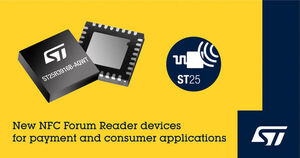
STMicroelectronics’ newest NFC readers accelerate payment and consumer application designs
"STMicroelectronics’ ST25R3916B-AQWT and ST25R3917B-AQWT NFC Forum Reader devices combine high output power and energy efficiency at a competitive price. Supporting NFC initiator, target, reader, and card-emulation modes, they can be used in contactless-payment, device-pairing, wireless-charging, brand protection, and other industrial and consumer applications. The new devices introduce improved active wave shaping (AWS) with increased flexibility that simplifies adjustment of the RF output to optimize overshoot and undershoot. The setup can be done easily by register settings supported by a graphical tool and quickly validated with an oscilloscope. This eases certification according to EMVCo 3.1a and NFC Forum CR13 specifications without the need to touch the matching of the antenna. The ST25R3916B and the ST25R3917B deliver up to 1.6W RF output power and can drive antennas directly at high efficiency." [...]
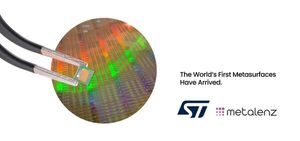
Metalenz and STMicroelectronics deliver world’s first optical metasurface technology for consumer electronics devices
"Metalenz metasurfaces are now on the market through its partnership with STMicroelectronics, marking the introduction of this revolutionary optical technology in real-world devices. Metalenz, the first company to commercialize meta-optics, and STMicroelectronics (NYSE: STM), a global semiconductor leader serving customers across the spectrum of electronics applications, today announce that ST’s currently released VL53L8 direct Time-of-Flight (dToF) sensor is the highly anticipated market debut of the meta-optics devices developed through their partnership, which was disclosed in June 2021. Metalenz’s Harvard-born, meta-optics technology can replace existing complex and multi-element lenses and provide additional functionality with a single meta-optic embedded in time-of-flight (ToF) modules from ST, the leading company in supplying 3D sensing modules. The introduction of Metalenz technology in these modules brings performance, power, size, and cost advantages to a multitude of consumer, automotive, and industrial applications. This marks the first time metasurface technology is commercially available and being used in consumer devices. Unlike traditional molded and curved lenses, Metalenz’s novel optics are completely planar." [...]

2nd-generation multi-zone direct Time-of-Flight sensor from STMicroelectronics uses less energy and can range 2X as far as existing products
"STMicroelectronics (NYSE: STM), a global semiconductor leader serving customers across the spectrum of electronics applications, has announced its newest FlightSense™ Time-of-Flight (ToF) ranging sensor for smart-phone camera management and augmented/virtual reality. With significant enhancements to many key components, ST’s latest ToF module offers up to double the ranging performance – up to 4m in all zones indoors — while reducing the power consumption by half compared to the previous-generation device, when operating in common conditions. “ST’s ToF technology has enjoyed massive commercial success, now shipping in more than 200 smartphone models and 100 PC, projector, and robotic products. Now, VL53L8 FlightSense sensor takes ranging performance and power efficiency to new levels,” said Eric Aussedat, Executive Vice President and General Manager of the Imaging Sub-Group within ST’s Analog, MEMS and Sensors Group. “Our latest-generation ranging sensor is a game changer. With its innovative metasurface lens technology and power-efficient architecture, it reduces battery loading, extends camera autofocus ranging, and enhances scene-understanding features.” Developed in partnership with Metalenz, the world’s first optical metasurface technology enables optical systems to collect more light, provide multiple functions in a single layer, and deliver new forms of sensing in smartphones and other devices, all in its compact package." [...]

Even more pi in the sky: Calculating 100 trillion digits of pi on Google Cloud
"Records are made to be broken. In 2019, we calculated 31.4 trillion digits of π — a world record at the time. Then, in 2021, scientists at the University of Applied Sciences of the Grisons calculated another 31.4 trillion digits of the constant, bringing the total up to 62.8 trillion decimal places. Today we're announcing yet another record: 100 trillion digits of π. This is the second time we’ve used Google Cloud to calculate a record number1 of digits for the mathematical constant, tripling the number of digits in just three years. This achievement is a testament to how much faster Google Cloud infrastructure gets, year in, year out." [...]
Ciência e Tecnologia

Simulating a Quantum Future
"Quantum computers are expected to revolutionize the way researchers solve difficult computing problems. These computers are being designed to tackle major challenges in fundamental research areas, such as quantum chemistry. In its current stage of development, quantum computing is still very sensitive to noise and disruptive factors in the environment. This makes quantum computing “noisy” as quantum bits—or qubits—lose information by getting out of sync, a process called decoherence. To overcome the limitations of current quantum computers, researchers at Pacific Northwest National Laboratory (PNNL) are developing simulations that provide a glimpse into how quantum computers work. “When we try to directly observe the behavior of quantum systems, like qubits, their quantum states will collapse,” said PNNL Computer Scientist Ang Li." [...]

Controlling the Waveform of Ultrashort Infrared Pulses
"An international team of laser physicists of the attoworld team at LMU and the Max Planck Institute of Quantum Optics has achieved unprecedented control over light pulses in the mid-infrared wavelength range. Ultrashort infrared light pulses are the key to a wide range of technological applications. The oscillating infrared light field can excite molecules in a sample to vibrate at specific frequencies, or drive ultrafast electric currents in semiconductors. Anyone intending to exploit the oscillating waveform of ultrashort light pulses, to drive cutting-edge electro-optical processes for example, faces the same question — how to best control the waveform themselves. The generation of ultrashort pulses with adjustable waveforms has been demonstrated in different wavelength ranges like the UV-visible and the near-infrared. Physicists from the attoworld team at the LMU, the Max Planck Institute of Quantum Optics (MPQ) and the Hungarian Center for Molecular Fingerprinting (CMF) have now succeeded in generating ultrashort mid-infrared pulses and precisely controlling their electric-field waveforms." [...]
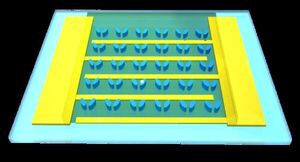
High-speed, efficient and compact electro-optic modulators for free space
"New photonic devices may have applications in lidar, optical computing and more Electro-optic modulators, which control aspects of light in response to electrical signals, are essential for everything from sensing to metrology and telecommunications. Today, most research into these modulators is focused on applications that take place on chips or within fiber optic systems. But what about optical applications outside the wire and off the chip, like distance sensing in vehicles? Current technologies to modulate light in free space are bulky, slow, static, or inefficient. Now, researchers at the Harvard John A. Paulson School of Engineering and Applied Sciences (SEAS), in collaboration with researchers at the department of Chemistry at the University of Washington, have developed a compact and tunable electro-optic modulator for free space applications that can modulate light at gigahertz speed. “Our work is the first step toward a class of free-space electro-optic modulators that provide compact and efficient intensity modulation at gigahertz speed of free-space beams at telecom wavelengths,” said Federico Capasso, Robert L. Wallace Professor of Applied Physics and Vinton Hayes Senior Research Fellow in Electrical Engineering, senior author of the paper." [...]
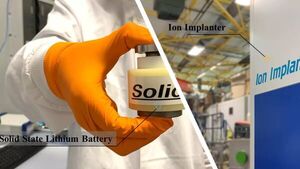
Lifespan of solid-state lithium batteries extended by Surrey researchers
"Researchers have successfully increased the lifespan and stability of solid-state lithium-ion batteries, creating a viable approach for future widespread usage. The strength of the new, high-density batteries produced by the University of Surrey means that they are less likely to short-circuit – a problem found in previous lithium-ion solid-state batteries. Dr Yunlong Zhao from the Advanced Technology Institute, the University of Surrey, explained: “We have all heard horror stories of lithium-ion batteries in transport settings, usually down to issues around cracked casing caused by exposure to stressful environments, such as extreme temperature changes. Our research proves that it is possible to produce more robust solid-state lithium-ion batteries, which should provide a promising approach for high-energy and safe future models to be used in real-life examples such as electric vehicles.” Using the state-of-the-art national facility at Surrey's Ion Beam Centre, the small team injected Xenon ions into a ceramic oxide material to create a solid-state electrolyte. The team found that their method created a battery electrolyte that showed a 30-times improvement in lifespan over a battery that had not been injected. Dr Nianhua Peng, co-author of the study from the University of Surrey, said: “We are living in a world that is far more aware of the damage humans are causing to the environment." [...]
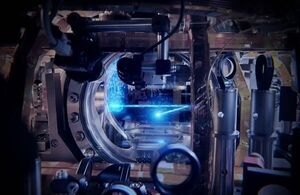
Eternal matter waves
"Amsterdam physicists build an atom laser that can stay on forever. Imagining our everyday life without lasers is difficult. We use lasers in printers, CD players, pointers, measuring devices, and so on. What makes lasers so special is that they use coherent waves of light: all the light inside a laser vibrates completely in sync. Meanwhile, quantum mechanics tells us that particles like atoms should also be thought of as waves. As a result, we can build ‘atom lasers’ containing coherent waves of matter." [...]
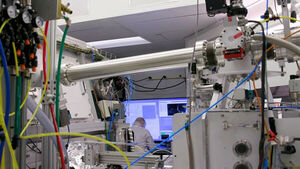
Pushing the Boundaries of Moore’s Law: How Can Extreme UV Light Produce Tiny Microchips?
"Advances in microelectronics – also known as microchips or chips – have enabled fast, powerful, compact smartphones and laptops – electronic devices that were once, long ago, the stuff of science fiction. Chips consist of miniaturized components called transistors – tiny silicon switches that process and store data as ones and zeroes, the binary language of computers. The more transistors a chip has, the faster it can process data. The most sophisticated chip today is about the size of a fingernail and consists of more than 100 billion transistors. Since the 1960s, the chip industry has relied on lithography – a technique that uses light to print tiny patterns on silicon to mass produce microchips. Through the decades, advances in lithography have enabled the use of smaller and smaller wavelengths and thus fabricate smaller transistors." [...]

Faster computing results without fear of errors
"Researchers developed a new system that can make computer programs run faster, while guaranteeing accuracy. Researchers have pioneered a technique that can dramatically accelerate certain types of computer programs automatically, while ensuring program results remain accurate. Their system boosts the speeds of programs that run in the Unix shell, a ubiquitous programming environment created 50 years ago that is still widely used today. Their method parallelizes these programs, which means that it splits program components into pieces that can be run simultaneously on multiple computer processors. This enables programs to execute tasks like web indexing, natural language processing, or analyzing data in a fraction of their original runtime. “There are so many people who use these types of programs, like data scientists, biologists, engineers, and economists." [...]
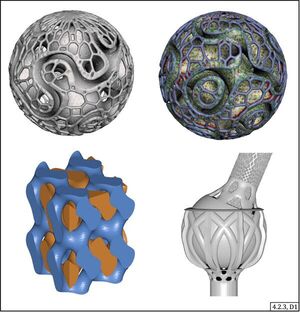
Updated Standard Provides Fundamental 3D-Printing Design Guidance to Streamline Production
"Since the 1940s, engineers have used a common design language — a set of definitions, symbols and practices — to draft engineering drawings that can serve as clear manufacturing blueprints or inspection checklists. While this system still works well for many traditional manufacturing methods, it has not equipped engineers to produce clear and consistent design documents for additive manufacturing, commonly called 3D printing. And the absence of standard methods of communication leaves room for information about 3D-printing designs to be lost in translation. This week the American Society of Mechanical Engineers (ASME) published an updated standard — based in large part on research by the National Institute of Standards and Technology (NIST) — that includes language specifically for 3D printing. ASME’s standard, titled Y14.46 Product Definition for Additive Manufacturing, identifies important features unique to 3D printing and outlines how they should be documented. The guidance could help engineers from a broad array of industries communicate to manufacturers, product inspectors and others more effectively." [...]
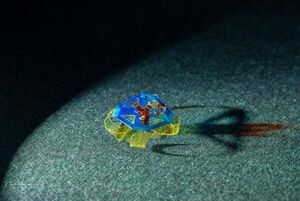
Collaborating on a real life Barbapapa
"The way cartoon character Barbapapa and his family members take on any shape they want has captured the imagination for generations. Making this a reality offers unprecedented possibilities. All the more understandable is the enthusiasm of the researchers at Eindhoven University of Technology who have joined forces in soft robotics. This is a new field with countless potential innovations: from an artificial heart to ultra-small robots that perform internal surgery, dispense medicines or repair complex machines. Plant-based food sensations, self-cleaning coatings or artificial ‘remote hands’ are also on the horizon. "Scientifically, it's an incubator for new directions and research", said Bas Overvelde, associate professor within the Soft Robotics Group (part of the Mechanical Engineering faculty) and scientific group leader of the Soft Robotic Matter Group at AMOLF." [...]
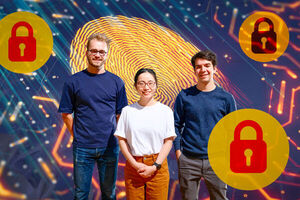
Keeping web-browsing data safe from hackers
"Studying a powerful type of cyberattack, researchers identified a flaw in how it’s been analyzed before, then developed new techniques that stop it in its tracks. Malicious agents can use machine learning to launch powerful attacks that steal information in ways that are tough to prevent and often even more difficult to study. Attackers can capture data that “leaks” between software programs running on the same computer. They then use machine-learning algorithms to decode those signals, which enables them to obtain passwords or other private information. These are called “side-channel attacks” because information is acquired through a channel not meant for communication. Researchers at MIT have shown that machine-learning-assisted side-channel attacks are both extremely robust and poorly understood." [...]
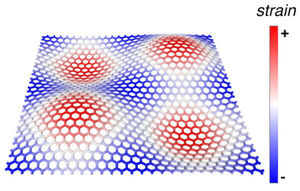
Bumps could smooth quantum investigations
"Rice University models show unique properties of 2D materials stressed by contoured substrates Atoms do weird things when forced out of their comfort zones. Rice University engineers have thought up a new way to give them a nudge. Materials theorist Boris Yakobson and his team at Rice’s George R. Brown School of Engineering have a theory that changing the contour of a layer of 2D material, thus changing the relationships between its atoms, might be simpler to do than previously thought. While others twist 2D bilayers -- two layers stacked together -- of graphene and the like to change their topology, the Rice researchers suggest through computational models that growing or stamping single-layer 2D materials on a carefully designed undulating surface would achieve “an unprecedented level of control” over their magnetic and electronic properties. They say the discovery opens a path to explore many-body effects, the interactions between multiple microscopic particles, including quantum systems. The paper by Yakobson and two alumni, co-lead author Sunny Gupta and Henry Yu, of his lab appears in Nature Communications." [...]

Researchers Demonstrate 40-Channel Optical Communication Link
"Researchers have demonstrated a silicon-based optical communicationvlink that combines two multiplexing technologies to create 40 optical data channels that can simultaneously move data. The new chip-scale optical interconnect can transmit about 400 GB of data per second — the equivalent of about 100,000 streaming movies. This could improve data-intensive internet applications from video streaming services to high-capacity transactions for the stock market. “As demands to move more information across the internet continue to grow, we need new technologies to push data rates further,” said Peter Delfyett, who led the University of Central Florida College of Optics and Photonics (CREOL) research team. “Because optical interconnects can move more data than their electronic counterparts, our work could enable better and faster data processing in the data centers that form the backbone of the internet.” A multi-institutional group of researchers describes the new optical communication link in the Optica Publishing Group journal Optics Letters. It achieves 40 channels by combining a frequency comb light source based on a new photonic crystal resonator developed by the National Institute of Standards and Technology (NIST) with an optimized mode-division multiplexer designed by the researchers at Stanford University." [...]

UQ discovery paves the way for faster computers, longer-lasting batteries
"University of Queensland scientists have cracked a problem that’s frustrated chemists and physicists for years, potentially leading to a new age of powerful, efficient, and environmentally friendly technologies. Using quantum mechanics, Professor Ben Powell from UQ’s School of Mathematics and Physics has discovered a ‘recipe’ which allows molecular switches to work at room temperature. “Switches are materials that can shift between two or more states, such as on and off or 0 and 1, and are the basis of all digital technologies,” Professor Powell said. “This discovery paves the way for smaller and more powerful and energy efficient technologies. “You can expect batteries will last longer and computers to run faster.” Until now, molecular switching has only been possible when the molecules are extremely cold - at temperatures below minus 250 degrees centigrade. “Engineering-wise, this is a big problem,” Professor Powell said." [...]

Air Lasing: A New Tool for Atmospheric Detection
"Ultrafast laser technologies provide new strategies for remote sensing of atmospheric pollutants and hazardous biochemical agents due to their unique advantages of high peak power, short pulse duration, and broad spectral coverage. Particularly, air lasing has become promising in atmospheric remote sensing due to its ability of generating cavity-free light amplification in the open air. It is suitable as an ideal probe for atmospheric diagnosis. Recently, a research team from the Shanghai Institute of Optics and Fine Mechanics (SIOM) of the Chinese Academy of Sciences (CAS) proposed an air-lasing-assisted coherent Raman spectroscopy, which realizes quantitative measurement and simultaneous detection of two greenhouse gases, as well as identification of CO2 isotopes. The detection sensitivity reaches 0.03% and the minimum signal fluctuation is about 2%. The work was published in Ultrafast Science on April 8." [...]

Colossal collisions linked to solar system science
"A new study shows a deep connection between some of the largest, most energetic events in the universe and much smaller, weaker ones powered by our own Sun. The results come from a long observation with NASA’s Chandra X-ray Observatory of Abell 2146, a pair of colliding galaxy clusters located about 2.8 billion light-years from Earth. The new study was led by Helen Russell from he School of Physics and Astronomy and has been published online by The Monthly Notices of the Royal Astronomical Society Galaxy clusters contain hundreds of galaxies and huge amounts of hot gas and dark matter and are among the largest structures in the universe. Collisions between galaxy clusters release enormous amounts of energy unlike anything witnessed since the big bang and provide scientists with physics laboratories that are unavailable here on Earth. In this composite image of Abell 2146, Chandra X-ray data (purple) shows hot gas, and Subaru Telescope optical data shows galaxies (red and white). One cluster (labeled #2) is moving towards the bottom left in the direction shown and plowing through the other cluster (#1)." [...]

Lithium-ion batteries that last longer in extreme cold
"When temperatures fall below freezing, cellphones need to be recharged frequently, and electric cars have shorter driving ranges. This is because their lithium-ion batteries’ anodes get sluggish, holding less charge and draining energy quickly. To improve electrical performance in the extreme cold, researchers reporting in ACS Central Science have replaced the traditional graphite anode in a lithium-ion battery with a bumpy carbon-based material, which maintains its rechargeable storage capacity down to -31 F. Lithium-ion batteries are great for powering rechargeable electronics because they can store a lot of energy and have long lifespans. But when temps fall below freezing, these energy sources’ electrical performance declines, and when conditions are cold enough, they can fail to transfer any charge. It’s why some people living in the U.S. Midwest have trouble with their electric cars in the dead of winter, and why it’s risky to use these batteries in space explorations. Recently, scientists determined that the flat orientation of graphite in the anode is responsible for the drop in a lithium-ion battery’s energy storage capacity in the cold." [...]

Study Reveals How Some High-Energy Particle 'Jets' Lose Energy
"Results may offer new insight into properties of quark-gluon plasma (QGP)—the hot mix of fundamental nuclear-matter building blocks that filled the early universe. Scientists studying particle collisions at the Relativistic Heavy Ion Collider (RHIC) have revealed how certain particle-jets lose energy as they traverse the unique form of nuclear matter created in these collisions. The results, published in Physical Review C, should help them learn about key “transport properties” of this hot particle soup, known as a quark-gluon plasma (QGP). “By looking at how jets of particles slow down as they move through the QGP, we can learn about its properties the same way studying how objects move through water can tell you something about its density and viscosity,” said Raghav Kunnawalkam Elayavalli, a postdoctoral fellow at Yale University and member of RHIC’s STAR experiment collaboration. But there are multiple ways a jet can lose energy—or be “quenched.” So, it can be hard to tell which of those causes is creating the quenching effect. With the new findings, for the first time, STAR has identified a specific population of jets for which the physicists say they can distinctively identify the mechanism: individual quarks emitting gluons as they interact with the QGP." [...]

Intersecting light beams key in transformative 3D printer potential
"QUT researchers have used intersecting light beams to control chemical reactions in an advanced material, paving the way for future use in 3D printers that print entire layers, instead of single points, at a time. QUT’s Centre for Materials Science interdisciplinary research team, made up of Dr Sarah Walden, Leona Rodrigues, Dr Jessica Alves, Associate Professor James Blinco, Dr Vinh Truong, and ARC Laureate Fellow Professor Christopher Barner-Kowollik, have published their research in Nature Communications. Dr Walden said light was a particularly desirable tool for activating chemical processes, because of the precision it offered in starting a reaction. “Most of the work QUT’s Soft Matter Materials Group researchers have done in the past with light has been to use a laser beam to start and stop a chemical reaction along the entire volume where the light strikes the material,” Dr Walden said. “In this case, we have two different coloured light beams, and the reaction only occurs where the two beams intersect. “We use one colour of light to activate one molecule, and the second colour of light to activate another molecule." [...]
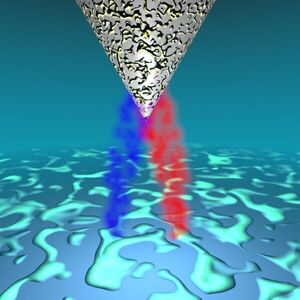
An atomic-scale window into superconductivity paves the way for new quantum materials
"Researchers have demonstrated a new technique to measure the quantum excitations in superconducting materials with atomic precision for the first time. Detecting these excitations is an important step towards understand exotic superconductors, which could help us improve quantum computers and perhaps even pave the way towards room-temperature superconductors. Superconductors are materials with no electrical resistance whatsoever, commonly requiring extremely low temperatures. They are used in a wide range of domains, from medical applications to a central role in quantum computers. Superconductivity is caused by specially linked pairs of electrons known as Cooper pairs. So far, the occurrence of Cooper pairs has been measured indirectly macroscopically in bulk, but a new technique developed by researchers at Aalto University and Oak Ridge National Laboratories in the US can detect their occurrence with atomic precision." [...]

Penn Engineers Create Chip That Can Process and Classify Nearly Two Billion Images per Second
"Artificial intelligence (AI) plays an important role in many systems, from predictive text to medical diagnoses. Inspired by the human brain, many AI systems are implemented based on artificial neural networks, where electrical equivalents of biological neurons are interconnected, trained with a set of known data, such as images, and then used to recognize or classify new data points. In traditional neural networks used for image recognition, the image of the target object is first formed on an image sensor, such as the digital camera in a smart phone. Then, the image sensor converts light into electrical signals, and ultimately into the binary data, which can then be processed, analyzed, stored and classified using computer chips. Speeding up these abilities is key to improving any number of applications, such as face recognition, automatically detecting text in photos, or helping self-driving cars recognize obstacles. While current, consumer-grade image classification technology on a digital chip can perform billions of computations per second, making it fast enough for most applications, more sophisticated image classification such as identifying moving objects, 3D object identification, or classification of microscopic cells in the body, are pushing the computational limits of even the most powerful technology." [...]
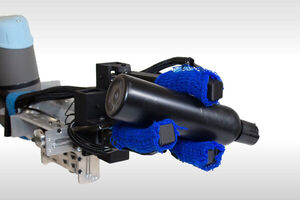
A helping hand for robotic manipulator design
"With modular components and an easy-to-use 3D interface, this interactive design pipeline enables anyone to create their own customized robotic hand. MIT researchers have created an interactive design pipeline that streamlines and simplifies the process of crafting a customized robotic hand with tactile sensors. Typically, a robotics expert may spend months manually designing a custom manipulator, largely through trial-and-error. Each iteration could require new parts that must be designed and tested from scratch. By contrast, this new pipeline doesn’t require any manual assembly or specialized knowledge. Akin to building with digital LEGOs, a designer uses the interface to construct a robotic manipulator from a set of modular components that are guaranteed to be manufacturable." [...]

Radio waves for the detection of hardware tampering
"Up to now, protecting hardware against manipulation has been a laborious business: expensive, and only possible on a small scale. And yet, two simple antennas might do the trick. As far as data security is concerned, there is an even greater danger than remote cyberattacks: namely tampering with hardware that can be used to read out information – such as credit card data from a card reader. Researchers in Bochum have developed a new method to detect such manipulations. They monitor the systems with radio waves that react to the slightest changes in the ambient conditions. Unlike conventional methods, they can thus protect entire systems, not just individual components – and they can do it at a lower cost." [...]
Projetos Maker
Diversos Projetos interessantes.

Basic Motor PWM Speed Control With 555IC
"Abstract This project is about, controlling a fan using 555IC with PWM. PWM is controlled with a potentiometer. I drove a fan but you can use it for a DC motor. The circuit has a back-emf diode. I did this project using a prototyping board but if you want to produce the PCB, I will share the Gerber files too. Features - Input has a 500mA fuse for protection." [...]
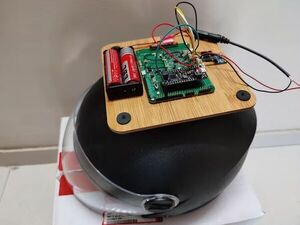
Building a Smart Helmet with the Blues Wireless Notecard
"A smart helmet which can track the user location and detect a fall using a MPU6050 IMU based fall detector We are living in the age of digitization and smart IoT devices. With advances in technology in the last few years it is even more important that we use those technologies in an effective manner. Human and worker safety is one important topic. While riding a bike, a car, or working at a factory, almost everyone of us is at a risk of accidents to some extent. When someone is either working in a remote area or is on their own it may be necessary to keep watch and be informed about their location as well as their status using sensor data. For safety reasons fall detection and alerting after one has fallen is an important thing to monitor." [...]
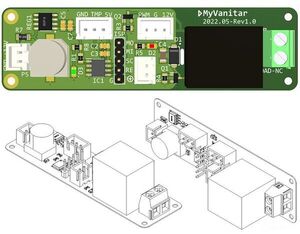
PWM Cooling-FAN Control and Over Temperature Protection using LM35 and ATTiny13
"Proper thermal dissipation is an essential rule for nowadays electronics. The best operating temperature for the electronic components is 25 degrees (standard room temperature). Thermal dissipation in some commercial devices is not done properly which affects the lifetime and performance of the devices. So, embedding a compact automatic cooling Fan controller board would be useful. Also, it can be used to protect your own designed circuits and their power components, such as regulators, Mosfets, power transistors … etc. Previously, I had introduced a circuit to control the cooling fans, however, my intention was not to use any microcontroller and keep it as simple as possible." [...]

WatchEye - One Eyed Pet With Face Tracking
"WatchEye - One-eyed Pet With Face Tracking I enjoyed the Instructable "Twitch" very much and it was very inspiring: an electronic pet that reacts to touch and blink with its eye. But I wanted a pet that could really look at me. My project looks like "Twitch - Your Robotic Pet" and I copied the blinking eye, but the inner life and function are quite different. Here is WatchEye Supplies: - ESP32-cam (with FTDI) - Pan & Tilt kit - 2x SG90 servo motors - PIR sensor - LED matrix 8x8 (green) - switch - box" [...]
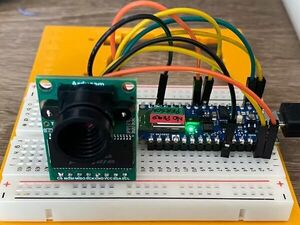
Embedded Machine Learning for Person Detection
"Is easy to run large Machine Learning models in the cloud with large computational and memory resources. What about in the Arduino Nano? Deep Learning Workflow In this project, the steps followed to implement our person detection application are the book referenced [1]: Decide the goal –person detection using Arduino Nano BLE 33 and Arducam Collect a dataset – VisualWake Words (derived from COCO dataset) Design a ModelArchitecture – Convolutional Neural Networks – MobileNet v1 Train the Model – Training, validation and test Convert the Model –using TensorFlow Lite Converter Run Inference – Output data – Person Detected and Not detected scores, green/red light Evaluate andTroubleshoot – Real world performance Convert the Model In a normal environment, TensorFlow is used to build and train large Machine Learning models. A TensorFlow model is a set of instructions that tell an interpreter how to transform data in order to produce an output. To use our model, we load into the memory and execute it using the TensorFlow interpreter. TensorFlow interpreter is supposed to be run in powerful desktop computers and servers." [...]
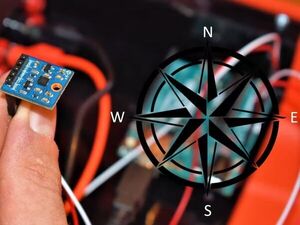
3-Axis Magnetometer
"Measure the magnitude and direction of Earth's magnetic field with the HMC5883L 3-axis magnetometer. Introduction In this project, we’ll be interfacing the HMC5883L 3-axis magnetometer to an Arduino Uno. This device can measure the magnitude and direction of the Earth’s magnetic field. It’s a low-power device and can be found in mobile phones or navigation systems to provide an accurate compass heading. You can also use them to detect ferrous (contains iron) metals since the iron within the metal changes the magnetic field when it’s in close proximity to the sensor. Don’t get lost out there, let’s get started!" [...]
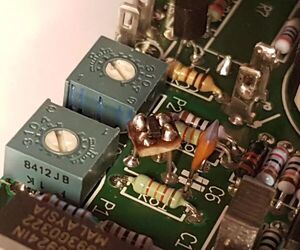
The World's Smallest Prototyping Board
"Matching an SO-23 Chip to a TO-92 Footprint. The picture above shows one of my home-brew proto board adapters with an SO-23 chip, in action on a populated and soldered PCB. In the background, a standard TO-92 transistor can be partly seen, too. Soldering SMD (Surface Mounted Devices) chips with two, three or multiple terminals on a PCB is a hefty challenge for us oldtimers with the visual impairment and the shaky hands - but we give as good as we get, and we accept the dare! Replacing an IC in the standard DIL (Dual-In-Line) package by its tiny SMD equivalent - just because the DIL package was considered obsolete by the manufacturers and cannot be supplied anymore - is, in fact, an easy task: For the variety of 8, 14 or more pins, our friends from banggood.com (or similar) can supply adapter PCBs for little money (search term 'SMD adapter'). Since the shipment from China takes a lot of time, it might be a good idea to purchase some of them before you actually need them." [...]
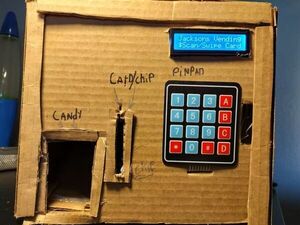
Vending Machine with RFID
"A simple code and design to build a vending machine with cardboard or a 3D printer! I've seen so many YouTube videos and pictures of people making things like this however they never gave the code; so, I decided to make my own, the code for this was made especially for a vending machine or other things similar. How does it work: To make this work you need to replace the RFID chip UID in the code with your own, after only the specified chip will be able to work. after you can set a 4-digit pin number with no letters to have as extra security. Extra: On the breadboard, you can have a yellow LED or buzzer however buzzer is quite obnoxious. " [...]
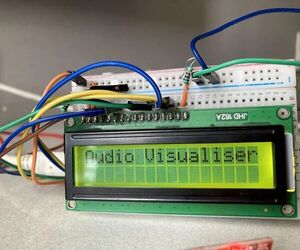
Audio Visualizer With an LCD Display
"Welcome to my third Instructable. People love listening to music. It is as they say, music reflects our mood. And it is a spectacle to see music become 'alive' right before our eyes. Well, that's what music visualization does. According to Wikipedia, music visualization "generates animated imagery based on a piece of music." [...]

Badger 2040 Keypad
"The Badger 2040 keypad is an inexpensive programmable USB macro keypad with keymap display. The firmware is based on CircuitPython and can be easily extended by yourself. If you just want to customize key bindings, you don't even need to know how to program, as there is a configuration file for this that you can easily edit in a text editor. Since the firmware is an extension of my PicoSplit firmware, it offers the possibility to assign multiple functions to keys. You can store key assignments for several programs and each program can also have several key assignments. You can easily switch between programs and their key assignments." [...]
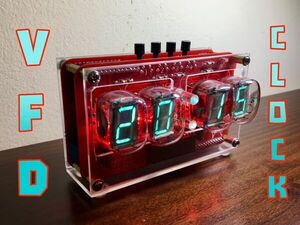
Homemade IV-22 VFD Clock!
"Glowing retro tubes made in the Soviet Union? 80's electro-style? Sign me up! (or sign us up comrade?) Many of you probably know how these things go: you start with making a nixie clock and you end up with a self full of Soviet tube clocks! That's what happened to me as well: while researching nixie tubes I found out about VFDs, the display technology that replaced nixies." [...]
DIY Fitness Tracker(GET-FIT)
"Introducing GetFit, your ultimate health and workout partner. GetFit is an easy-to-use, teachable fitness tracker with the capability of detecting an endless variety of exercises. Powered by Arduino Nano 33 BLE Sense and Edge Impulse, it is a completely open-source project. Features - Can Count unlimited exercises - Fully open-source - Teachable - Rechargeable - Calorie Burn Estimation on a daily and weekly basis Supplies: For doing this project we are using, Arduino nano 33 BLE sense. It's a 3.3V AI-enabled board in the smallest available form factor. It comes with a series of embedded sensors." [...]
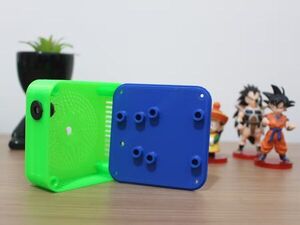
Smoke Detector with Arduino
"You'll learn how to create a Smoke Detector with Arduino and download your own 3D Enclosure. Story In many homes, accidents with cooking gas occur because people forget to close the valve. The gas leaks and can generate two major accidents: explosion or death by aspiration in large quantities during sleep. One of the ways to avoid this is through a gas presence monitoring system. This is done through the use of sensors. In this article we will build a system to monitor the presence of cooking gas." [...]
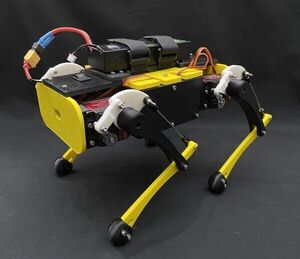
3D Printed Robot Dog
"In 2020 I became immersed in the marvelous world of quadrupedal robots. Viewing YouTube videos of robots such as SPOT by Boston Dynamics, and the MIT Mini Cheetah has inspired me to make my very own. These cleverly crafted bots are known for their dynamic movements and realistic appearances. Over the past year, I've made it my personal goal to create my very own affordable quadrupedal robot. One that could function similar to the high-end quadrupeds. Here I present ARES, a fully 3D printed 12 DOF robot dog capable of omni directional travel as well as many other maneuvers." [...]

Seeed Studio XIAO RP2040 18 Key Numpad
"A minimalist 18 key numpad using the Seeed Studio XIAO RP2040, a single analogue pin, and room for expansion! Story If you're anything like me, you have a relatively modern and compact laptop as your main computing device - but it doesn't have a numpad, it has a row of keys along the top. This is frustrating, as I do quite of bit of number input for both my day job and hobbies. So, I could buy a relatively cheap (and potentially wireless) numpad, I could buy a new laptop - or I could make a project out of it and design my own!Documented below is how I went about it, with the included files if you wish to make your own. It's a real pleasure to use, and could be used for other purposes as well! Macropads are quite common nowadays, for gaming streaming, design, and more, and having a pad to suit your specific use case is very handy." [...]

Antipong Console
"In this instructable we'll be making a small game console that plays an inverted version of pong. In this version of pong you'll be dodging the balls instead of "ping-ponging" them over to another player, see how long you can last! Supplies: // mainboard // Arduino uno ( we used rev.3). // electronic parts // Adafruit SSD1306. Standard PushButtons - 3x. Piezo buzzer." [...]

3V3 Power Supply system for ESP8266
"Every microcontroller requires to be powered by a specific input voltage and ESP8266 being a microcontroller can not be left out. ESP8266 is a microchip of low cost that is produced by a company by the name of ESPPRESSIF stems. It has been used in the revolution of cloud communication systems in the field of electronics as it has Wi-Fi and Bluetooth communications capabilities. The microcontroller has several pinouts. In this article, we are going to focus on the 3v3 pin which is where the powering of the ESP8266occurss. This 3V3 means that the ESP8266 is powered by the use of the 3.3V and therefore we need to ensure that before we power this system we are doing it with the right voltages or else we might end up creating more damage." [...]

Streaming Video on 1602 Character LCD Display With Arduino
"What makes this project special is that we are going to render graphics on a text LCD display which is not supposed to be used this way. Since you cant control any particular pixel, this idea appears to be more of a pipe dream than a realistic plan. And this is why you should try it and push the hardware limits. Spoiler: it will not run DOOM for now, but it will run "Bad Apple"! HARDWARE A character LCD display. The most common is 1602." [...]
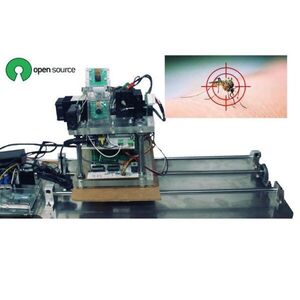
Laser device for neutralizing - mosquitoes
"Low-cost device for control mosquitoes, weeds, pest etc. This is an innovative and effective method for remote monitoring of mosquitoes and their neutralization. Was explained in detail how was leveraged modern advances in neural networks to use a powerful laser to neutralize mosquitoes. The experimental low-cost prototype for mosquito control uses a powerful laser to thermally neutralize the mosquitoes. The developed device is controlled by a single-board computer based on the neural network and demonstrated experimental research for mosquito neutralization during which, to maximize approximation to natural conditions, simulation of various working conditions was conducted. We showed that a low-cost device can be used to kill mosquitoes with a powerful laser." [...]
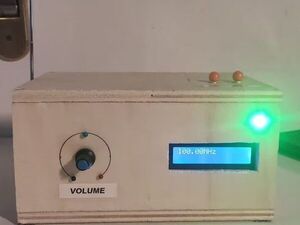
Radio Arduino Uno TEA5767
"This radio was made by using TEA5767 module radio. This radio use the radio module TEA5767 which can operate from 76Mhz to 108Mhz. Furthermore, using a spst switch, we can turn on and off the radio and see the frequency chosen on the LCD (this use I2C protocol) by two buttons that change the frequency value. In the last we can change the volume thanks to a potentiometer on an amplificator to whom are connected two speakers and save through the EEPROM the last frequency chosen. " [...]
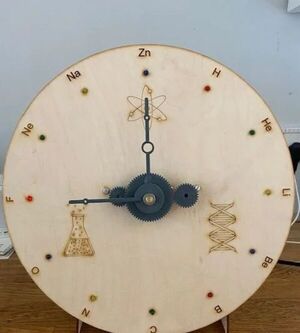
Arduino Science Clock
"I have toyed with the idea of building a clock for sometime and my sister had a big birthday coming up so I decided that this was a great opportunity to build a clock for her as a gift. My sister has a PhD in science and works as a science educator so I decided to make a science themed clock. I wanted to make the clock slightly different, the first thing that stands out with this clock is that it doesn't have numbers, I used the periodic table elements instead. For those of you that don't know here's a list of the elements I used with there corresponding number H-Hydrogen He-Helium Li-Lithium Be-Beryllium B-Boron C-Carbon N-Nitrogen O-Oxygen F-Fluorine Ne-Neon Na-Sodium Mg-Magnesium So rather than 6 O-Clock it is actually carbon o-clock etc. The clock has both digital and analogue systems for time keeping. The analogue system simply uses two stepper motors for moving the hands in hour or minute steps." [...]
Secção Videos
Videos interessantes.
That's all Folks!




